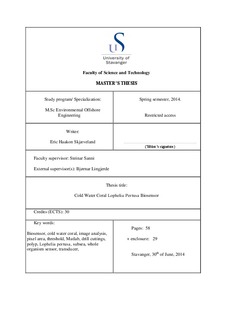| dc.contributor.author | Skjæveland, Eric Haakon | |
| dc.date.accessioned | 2015-01-13T13:10:39Z | |
| dc.date.available | 2015-01-13T13:10:39Z | |
| dc.date.issued | 2014-06-30 | |
| dc.identifier.uri | http://hdl.handle.net/11250/274007 | |
| dc.description | Master's thesis in Environmental technology | nb_NO |
| dc.description.abstract | The oil and gas industry is required to have a monitoring capacity that makes it possible to fulfill the regulatory requirements in the areas they operate today and intend to operate in the future. Because of the relative scarcity of new oil and gas fields in already explored offshore areas, the oil and gas industry is now moving to more challenging areas such as the Barents Sea where potential new resources may exist. Cold Water Corals (CWC) are present in the Barents Sea.
The development of CWC as part of a whole organism biosensor can provide a new tool to be used for early warning of leaks allowing implementation of corrective actions before an operational event develops into a serious environmental problem. Consequences of a late response can include breach of environmental permits, environmental harm and clean-up costs, loss of production and damage to reputation.
The oil and gas industry is obliged to have control of their environmental footprint. Current technology is limited to short and offline environmental effect campaigns using sampled bivalves followed by analysis in lab. CWC can provide a real-time presentation of analyzed behavioral data. This will be in line with anticipated future requirements from the Authorities.
One of the major environmental target compounds that can result from accidental discharges at sea is drill cuttings (DC). The thesis experiment is using DC to expose the CWC as the impurity to be tested against. The development of a real time biosensor capable of capturing images of coral nubbins and measuring the individual polyp activity was accomplished. This was done by utilizing pixel area fraction calculations on thresholded images of L. pertusa polyp images. The software was developed and run entirely through Matlab.
Further research on reducing uncertainties and making the sensor more reliable by removal of false signals from the image analysis are advised with suggestions for improvements. | nb_NO |
| dc.language.iso | eng | nb_NO |
| dc.publisher | University of Stavanger, Norway | nb_NO |
| dc.relation.ispartofseries | Masteroppgave/UIS-TN-IMN/2014; | |
| dc.rights | Attribution 3.0 Norway | * |
| dc.rights.uri | http://creativecommons.org/licenses/by/3.0/no/ | * |
| dc.subject | teknisk miljøvern | nb_NO |
| dc.subject | offshore teknologi | nb_NO |
| dc.subject | cold water coral | nb_NO |
| dc.subject | Barentshavet | nb_NO |
| dc.subject | environmental technology | nb_NO |
| dc.subject | Lophelia pertusa | nb_NO |
| dc.title | Cold water coral Lophelia Pertusa biosensor | nb_NO |
| dc.type | Master thesis | nb_NO |
| dc.subject.nsi | VDP::Technology: 500::Environmental engineering: 610 | nb_NO |

